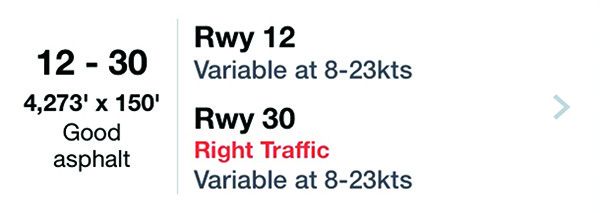The evening’s mission was to fly myself and a colleague to Williamsport, Pennsylvania, to attend a meeting the following morning. It was winter, with early sunsets, and we didn’t get airborne until well after dark, but I was night current, thanks to doing my instrument training at night, after work. I was close, but not ready for the rating checkride. A high overcast meant this VFR-only hop would be in dark night conditions, but the abundant ground lighting provided ample information on which way was up. The flight to IPT was uneventful and soon I had the destination airport in sight. We were the only aircraft at the then-non-towered airport. Winds were fairly strong and steady out of the north, so I chose Runway 30.
Maneuvering to enter the left downwind, I noticed the surface lights on a nearby ridge were really close. They distracted me and kept me high, but I didn’t think about it enough to extend the downwind to allow for a descent from the higher altitude. On final, I was way too high and fast for the Cherokee I was flying to get down and stopped, so I went around. Rejoining the left downwind, I slowed down and stayed about the same distance from the ridge as before. Extending the downwind slightly, I managed to convince the Cherokee to slow down and get down well enough that we made a decent landing, never mind that we used most of the runway.
The next day, after our meeting, we returned to the airport and were chatting with others in the FBO. In daylight, the ridge’s proximity to the runway was even more apparent and came up in the conversation. I wondered aloud about how close-in one needs to be to the runway for the left downwind. Which is when I was calmly informed that Runway 30’s pattern was to make right turns.
I was about as current as it gets, thanks to my night instrument training, and had something of an attitude, so I hadn’t done the due diligence necessary to fly into a strange airport at night. If I had looked closely at the chart or a flight data publication, I would have seen the note clearly stating Runway 30 was right traffic.
The lesson is to read the fine print, even if you think you know everything.
Have you encountered a situation or hazardous condition that yielded lessons on how to better manage the risks involved in flying? Do you have an experience to share with Aviation Safety’s readers about an occasion that taught you something significant about ways to conduct safer flight operations? If so, we want to hear about it.
We encourage you to submit a brief (500 words) write-up of your Learning Experience to Aviation Safety for possible publication. Each month, Aviation Safety publishes a collection of similar experiences sent to us by readers. Sharing with others the benefit of your experience and the lessons you learned can be an invaluable aid to other pilots.
You can send your account directly to the editor by e-mailing it to [email protected]. Put “Learning Experience Submission” in the subject line; add your name and daytime telephone number at the bottom of the e-mail.
Your report will be considered for publication in the Aviation Safety’s readers’ forum, “Learning Experiences,” and may be edited for style and length. Anonymity is guaranteed if you want it. No one but Aviation Safety’s editor is permitted access to the reports. Your name and telephone number are requested only so that the editor can contact you, if necessary.
While we can’t guarantee your submission will get published, we can guarantee that we’ll closely review and consider using it.
All Learning Experience submissions become the property of Aviation Safety and may be republished.




